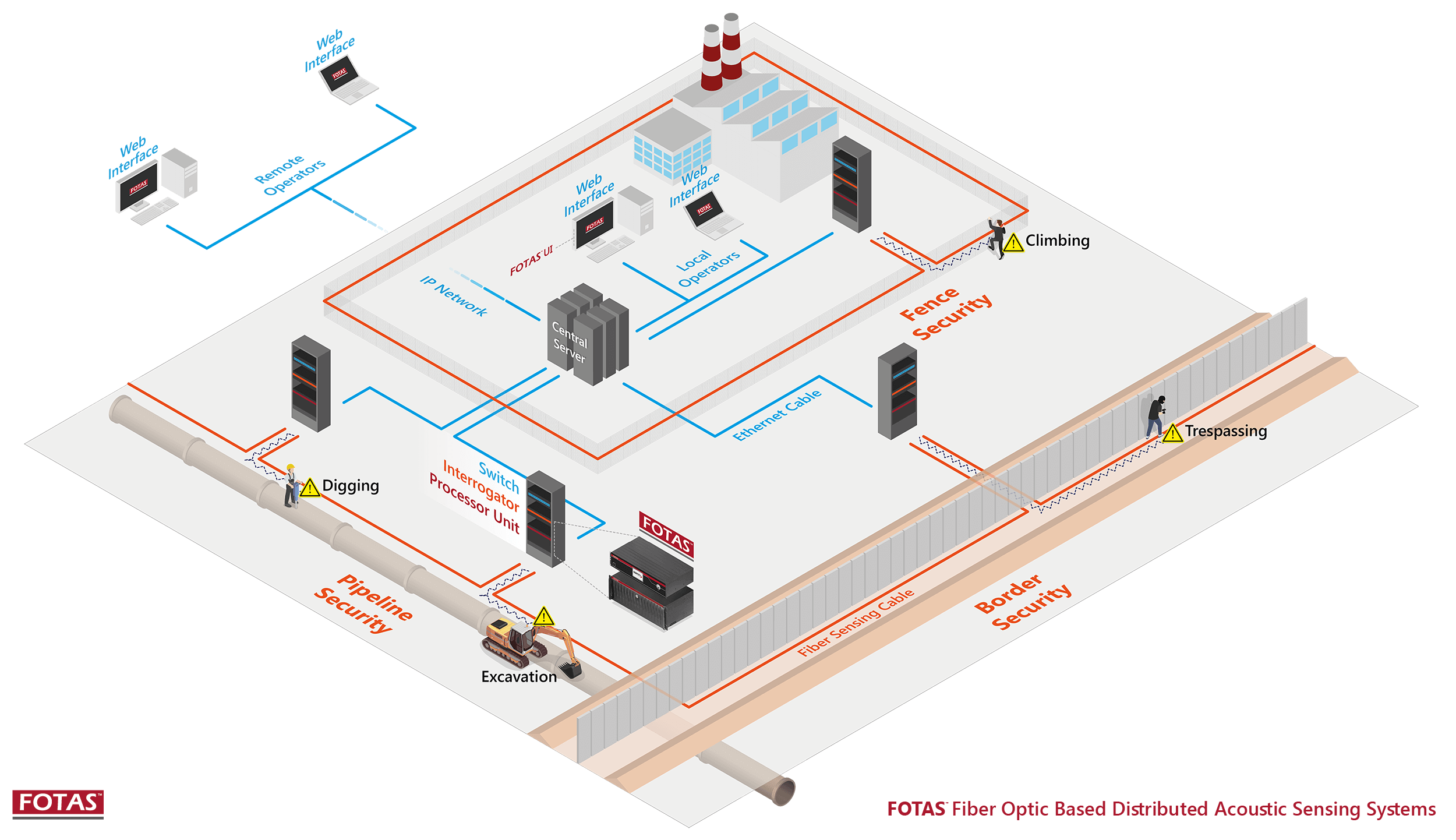The Ultimate Overview to Fiber Optic Safety Systems for Your Company
In an era where safety issues are paramount for organizations, comprehending the details of fiber optic innovation can be transformative. This guide lays out exactly how integrating fiber optic security systems not only improves data protection yet additionally offers benefits like resistance to interference and real-time surveillance abilities.
Understanding Fiber Optic Innovation

The core of a fiber optic wire consists of a thin glass or plastic center, bordered by a cladding layer that shows light back right into the core. fiber optic security system. This layout makes sure very little loss of signal strength, even over substantial distances. There are 2 key kinds of fiber optic cords: single-mode and multi-mode. Single-mode fibers are created for long-distance transmission, while multi-mode fibers are appropriate for shorter ranges, usually made use of within buildings.
Optical fiber are not only faster yet likewise much more safe than standard circuitry. Their intrinsic resistance to electromagnetic disturbance and the difficulty of using the signal without detection make them a favored option for organizations prioritizing data honesty and security. As organizations progressively count on safe and effective interaction systems, understanding fiber optic technology comes to be crucial for notified decision-making.
Trick Benefits of Fiber Optic Protection
When taking into consideration protection options for a service, the advantages of fiber optic systems are specifically compelling. Fiber optic technology offers remarkable data transmission rates and bandwidth capability, making it ideal for dealing with high-resolution video feeds from monitoring video cameras. This capacity makes sure that safety and security personnel receive real-time data, improving general response times to prospective security threats.
Moreover, fiber optic wires are naturally immune to electro-magnetic disturbance, which can compromise the integrity of conventional copper-based systems. This resistance ensures that the information sent stays secure and nonstop, offering a much more reputable security framework. Furthermore, fiber optics are much less vulnerable to physical damages, as they are made from glass instead of steel, lowering maintenance prices and downtime.
One more substantial benefit is the raised scalability of fiber optic systems. As service demands advance, fiber networks can be easily expanded to fit additional safety devices without significant overhauls to the existing infrastructure. Fiber optic systems use boosted cybersecurity features, consisting of file encryption capacities that safeguard delicate information from unapproved gain access to. Jointly, these advantages make fiber optic security systems a durable option for organizations seeking to enhance their safety and security actions.
Installment Refine and Considerations
Taking into consideration the intricacies entailed, the installment procedure of fiber optic safety and security systems needs cautious preparation and implementation. The preliminary step includes a detailed site analysis to recognize optimal locations for cabling and devices. This evaluation ought to think about environmental elements, existing facilities, and prospective vulnerabilities.

Furthermore, the setup has to abide by neighborhood structure codes and sector standards. This may consist of collaborating with different stakeholders such as structure supervisors, IT groups, and protection employees to make sure smooth assimilation with existing systems.
Post-installation, strenuous testing is necessary to validate system performance and determine any concerns that might occur. By focusing on these considerations during the installation procedure, services can guarantee a robust and reliable fiber optic safety system that satisfies their specific security requirements.
Newest Developments in Fiber Optic Security
Current innovations in fiber optic technology have actually considerably boosted the abilities of security systems for businesses. Among the most remarkable developments is the assimilation of fiber optic sensors that can detect vibrations and breaches along the boundary of a center. These sensors supply real-time monitoring, making it possible for rapid action to potential breaches.
In addition, the development of distributed fiber optic picking up technology enables the continuous tracking of huge areas with a solitary click over here now fiber wire. This method not only minimizes installment expenses yet also enhances the integrity of monitoring systems by removing the need for several, different sensing units.
Moreover, advancements in multiplexing methods have actually made it possible for businesses to transfer vast amounts of data over fiber optic networks, improving the capacities of video clip surveillance systems. High-definition video feeds can currently be sent out over fars away without loss of quality, guaranteeing that safety employees have accessibility to clear and workable details.
Lastly, using expert system (AI) combined with fiber optic systems is transforming risk detection. AI algorithms can evaluate data from fiber optic networks to determine unusual patterns or habits, permitting proactive protection procedures. These developments collectively represent a significant jump onward in fiber optic safety modern technology.
Picking the Right System for Your Business
Picking the ideal fiber optic security system for your business is critical for making sure ideal defense and assurance. To make an educated selection, assess your details safety requirements, considering factors such as the size of your properties, the nature of your procedures, and potential susceptabilities.
Begin by examining the degree of security called for; for example, high-risk settings might necessitate advanced systems with incorporated surveillance and breach discovery capacities. Next, consider scalability; as your organization grows, your protection system must can increasing to fit enhanced needs without substantial overhauls.
Furthermore, explore the dependability and efficiency of various systems. Search for carriers with recognized credibilities and client testimonies that vouch for their service quality. It's also a good idea to ask about the technology's compatibility with existing infrastructure, making sure a smooth assimilation process.
Final Thought
In verdict, fiber optic safety systems present a robust remedy for improving company protection infrastructures. The most recent advancements even more strengthen helpful hints the efficiency of these systems, guaranteeing that businesses continue to be protected and versatile in an ever-evolving danger landscape.